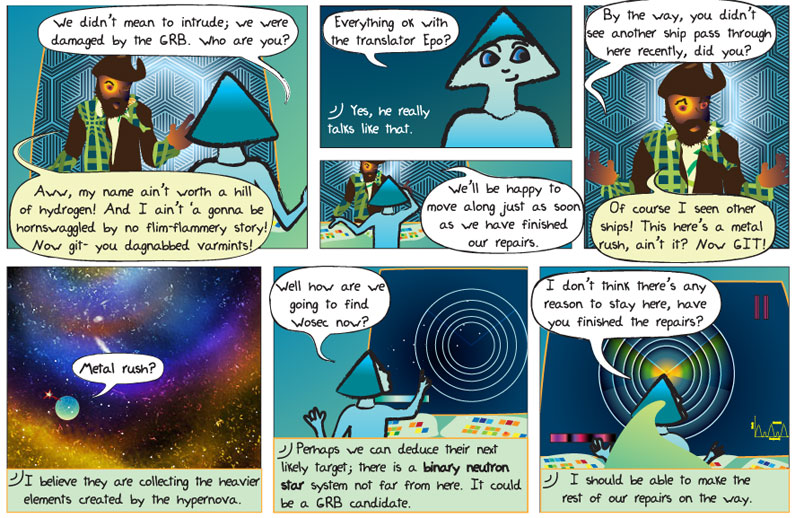
Comic Transcript
Panel 1.
Alkina: We didn’t mean to intrude; we were damaged by the GRB. Who are you?
Prospector: Aww, my name ain’t worth a hill of hydrogen! And I ain’t ‘a gonna be hornswaggled by no flim-flammery story! Now get you dagnabbed varmints!
Panel 2.
Alkina: Everything OK with the translator, Epo?
Epo: Yes, he really talks like that.
Alkina: We’ll be happy to move along just as soon as we have finished our repairs.
Panel 3.
Alkina: By the way, you didn’t see another ship pass through here recently, did you?
Prospector: Of course I seen other ships! This here’s a metal rush, ain’t it? now GIT!
Panel 4.
Alkina: Metal rush?
Epo: I believe they are collecting the heavier elements released by the hypernova.
Panel 5.
Alkina: Well, how are we going to find Wosec now?
Epo: Perhaps we can deduce their next likely target; there is a binary neutron star system not far from here. It could be a GRB candidate.
Panel 6.
Alkina: I don’t think there’s any reason to stay here, have you finished the repairs?
Epo: I should be able to make the rest of our repairs on the way.
What does it mean?
Binary – The word binary simply means there are two of something. When applied to a star system, it means that instead of having a single star, two stars orbit their common center of gravity.
Neutron star – The collapsed core of a massive star, made up mostly of neutrons. It has a very small size, with a diameter of about 10 km, the same size as a small city. However, the mass of a neutron star is very large for its size, at least 1.4 times the mass of our Sun. With so much mass stuffed into such a small volume, the density of a neutron star is around a billion tons per teaspoon.
In human speak please!
All the substances with which we are familiar are composed of only 92 basic chemical building blocks. These are the chemical elements, with the lightest one being hydrogen, and the heaviest being uranium. Have you ever wondered where the chemical elements come from? You might answer that they are mined out of the ground. That is certainly true for many of them, but how did they get there in the first place? If you trace elements back far enough, essentially all of them come from one place: stars. They are the places where the Universe makes most of its elements. Stars are powered by the process of nuclear fusion, where lighter elements are fused (combined) together to form heavier elements. The fusion process happens inside the star’s core, where it liberates large amounts of energy. This energy provides the heat and pressure to support the star’s mass from collapsing due to gravity.
When a star runs out of light elements to fuse, it reaches the end of the nuclear burning phase of its lifecycle. The massive stars, more than 10 times more massive than the Sun, will have created a core of iron at this point. The stellar core then collapses, and the star explodes as a supernova or hypernova. The expanding remnant of these explosions contains many of the heavy elements that the star spent millions of years producing. Additional elements, heavier than iron, are produced during the explosion itself. Some of these elements will find their way into the proto-planetary disk of a forming solar system, where they will be used to create new planets. This is how Earth and the other planets of the solar system obtained their silicon, oxygen, iron and other heavy elements when they formed long ago.
While the stars are responsible for the production of all the heavy elements in the Universe, the two lightest and most common elements, hydrogen and helium, are not produced by stars. In fact, they form the fuel that stars consume to produce heavier atoms. Some of the hydrogen and helium on Earth are produced via nuclear decays (helium) or through chemical processes (hydrogen). But the vast majority of the hydrogen and helium that exists had its origins before the first stars were formed, in the event that gave rise to the Universe itself.
Is that all?
What Happens Inside a Star – The formation of high mass elements.
Periodic table of elements – A table of all the elements currently known to us. Elements with atomic number (that is, the number of protons in an element) up to 92 are created in stars or supernovae. Heavier elements than those are created in by scientists in laboratories or nuclear reactors.
Multimedia? Yep, we’ve got it right here!
A video featuring scientists explaining where the heavier elements in the Universe come from.
An animation (no sound) of a supernova and the resulting remnant.
